The choice of a kitchen knife for professional chefs is an entire science with its own terminology, secrets and rules - after all, for them the knife is almost an extension of the hand. We, the townsfolk, to understand all the intricacies of this science and have a full set of tools is not necessary, but everyone will be able to learn how to distinguish good kitchen knives from bad ones.
Briefly about the main thing
If you do not want to dive into a short course on the choice of knives and you need only one high-quality multi-purpose knife, we offer the following solutions:
- The best choice for men: the so-called "chef's knife" (chef's knife, French knife) made of stainless steel with a length of 20-25 cm (universal length - 21 cm or 8 inches). This tool can make 80% of all work: cut, cut, grind, chop, repel. Manufacturers: The most expensive and best - vintage brands Wusthof and Zwilling J.A. Henckels (in the photo below), the middle price category - “Victorinox” and “Arcos”, from the budget - quite decent “Tramontina” (in the photo below) and “Opinel”.
- The best choice for women: In the overwhelming number of women's hands, universal "kitchens" 13-16 cm long (or 5-6 inches) are best placed. This knife is a cross between a classic chef knife and a slicer and it does an excellent job with most types of work.
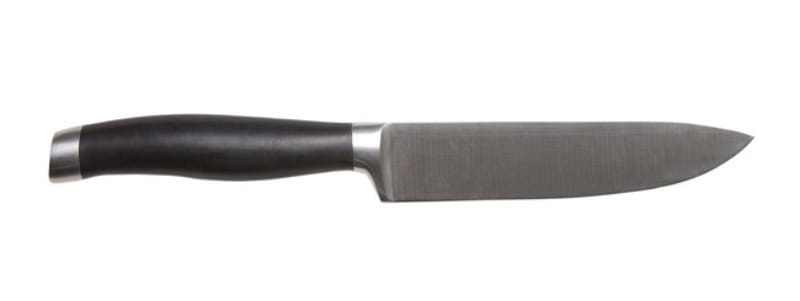
Manufacturers: top - all the same Wusthof, Zwilling J.A. Henckels, as well as F.Dick, Shun, etc., of the middle price category - “Victorinox” and “Arcos”, from the budget - quite decent kitchen knives “Tramontina”, Trupperware or “Opinel” made of carbon steel (in the photo below model number 102 with a blade length of 10 cm).

Opinel, model number 102, 10 cm
- Set of the main knives "kitchen three": a kitchen or a cook troika is a set of three knives that are most often used at home. Typically, this is:
- Chef-knife of general application - since this is the most important knife in the kitchen, then the question of how to choose the right copy of quality, we consider in more detail below;
- Serreytor for cutting bread, as well as puff cakes, vegetables, fruits 20-26 cm long - the knife has a serrated blade and is a bit like a saw. He perfectly cuts bread, not allowing him to wrinkle, delicately cuts the skin of tomatoes and other fruits and vegetables with a thin skin. Spending a lot of money on the purchase of such a knife is not worth it, the main thing is to find one so that the teeth of a serrated blade are not too large or too small. The average size of the teeth is, for example, this model of the Victorinoh company, but finding more affordable analogues is easy.

Victorinox Bread Knife 26 cm
- A knife for cleaning vegetables, chopping garlic and other “small” works, 8-10 cm (3-4 inches) long - to spend a lot of money on the purchase of this knife also does not make sense, so take one that you like in appearance and price.
Some more useful information.
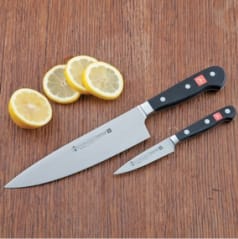
- You can buy a ready-made set of kitchen knives, or you can make your own arsenal.Ready kits, as a rule, buy more profitable than typing tools separately. But on the other hand, it is not always possible to find the perfect set in terms of composition and quality, moreover, it is much more reasonable to spend most of the budget (80%) on the purchase of a good chef knife, and you can save on the rest;
- Instead of a bread knife, you can purchase a knife with a regular blade, 13–16 cm long, for your Cook Three;
- In fact, the "kitchen trio" can be replaced by the "kitchen deuce" as in the photo on the right - a chef knife and a knife for cleaning vegetables;
- If, however, a couple of tools seem to you to be overkill, then feel free to acquire one chef's knife, but it’s high-quality and convenient for you. And although it always makes sense to read reviews and ratings, yet an excellent chef in price and quality can be found and unknown brands. The main thing you need to focus on is the quality of steel and how well the tool falls into your hand.
How to choose the right chef's knife, which can serve you for many years, read the next chapter or watch the video clip of the authoritative enthusiast and specialist Andrei Kozlovsky.
8 Tips to Know Before Buying a Chef Knife
First, let's formulate the general requirements for good kitchen knives:
- The blade remains sharp for a long time;
- The knife cuts food quickly and easily;
- The handle is comfortable in the hand and does not slip.
How to understand which kitchen knife meets this requirement, and which one does not? Here are 8 tips for choosing a versatile cooking tool.
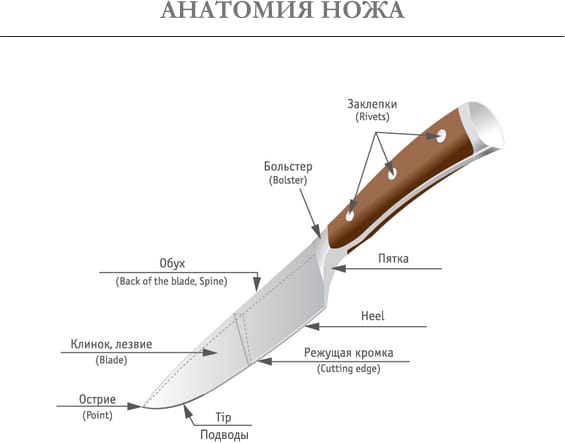
1. Evaluate your old knife
The concept of a “good knife” is partly subjective, because while one person may like the knife, to another person this same tool may seem inappropriate for his cutting style. Therefore, first you need to understand and formulate for yourself what you like and dislike in the old tool.
- Disadvantages may be the following: too heavy / light weight, too long / short blade, the blade quickly becomes dull or rust, butt rubs his finger during long cutting, the handle or the cut itself is not very convenient, for example, the knife does not fully cut the products during shredding and t .d
2. Choose the type of steel
The ability of the knife to remain sharp for a long time depends on the type and quality of the steel from which the blade is made. Kitchen knives are made of various types of steel, but most often it is:
- Stainless steel is the most common material, which is more suitable for the modern average user. The stainless steel quickly becomes dull (editing of kitchen knives from stainless steel is made, as a rule, 1 time in 1-1,5 months), but it does not require special care;
- Carbon steel (Carbon knife) - this alloy cuts better due to its hardness, the blade remains sharp for a long time, but at the same time it is more fragile, quickly rusts, reacts to acids and is covered with patina, therefore it requires special care and careful handling. But many professional chefs prefer this kind of steel. The next photo shows what a new carbon steel knife looks like and a darkened knife, covered with patina, which, by the way, does not affect the quality of the cut, but rather makes the blade more hygienic and, in our opinion, more noble in appearance.
- Should I buy ceramic knives? In our opinion, this is only an addition to the basic set of steel knives - although they remain sharp for a long time, their blades are too fragile, and if they do get dull, it will be almost impossible to sharpen them at home. However, it makes sense to buy inexpensive ceramic knives, which can be periodically changed.
3. How to inspect blades
- So that you can shred well, cutting the vegetables / fruits to the end, and also to save the main part of the cutting edge when cutting bones, choose a knife with an open heel, that is, when the blade is sharpened from the tip to the heel of the bolster. On the other hand, most chef knives come with a closed heel and many do not interfere. The photo below shows two types of chefs - with a closed and open heel.
- The thicker the blade, the better it is;
- The blade of a good chef should be smooth, and for high-grade stainless steel knives it should be completely mirrored;
- Pay attention to the quality of the butt treatment - it should be smoothed so that in the process of long cutting it does not make your fingers callused.
4. Inspection of the handle
- The highest quality tools are forged from a single piece of steel that passes through the entire knife - from the tip to the end of the handle. Thus, part of the steel is inside the handle between the two plates. Call this fragment a full shank. If the steel does not pass to the end of the handle, then it is called a half shank. Tools with a full shank better balanced, this is really an indicator of quality, but they are significantly more expensive.
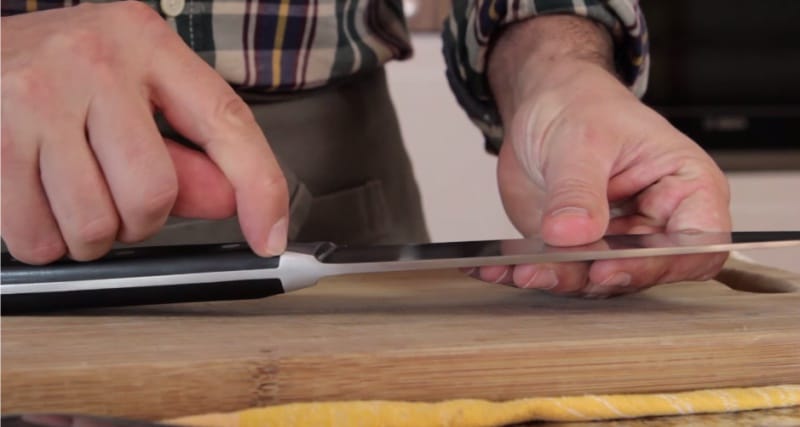
- The knife handle should be solid, tightly welded, strong - there should not be the slightest gap or weld in the joints of the parts. A badly welded handle becomes loose over time, and the knife cut will become less effective by reducing the pressure force on it, and moreover, dirt will collect in the joints of the handle.
- Consider also that the material should not be slippery or slippery because of the oil on the handle.
- As for the material of the plates, today most commonly used plastic, wood or rubber. Perhaps plastic, a composite of plastic and wood, as well as hard rubber are the best options.
5. Balance Test
If you want to buy a new high-quality knife, try using the example of an old chef (if you have one) to understand what kind of knife balance you need - with a heavier handle, with a heavier blade, or with a balanced blade and handle. It is believed that it is more convenient to use a balanced knife, and yet this is a very individual indicator. And, unfortunately, a balanced knife is not so easy to find, even among expensive specimens. To test the knife, you need to put the knife with a bolster on your finger as shown in the photo below and try to “catch” the balance. If the knife does not fall, then, most likely, this is a great copy. (be careful, keep in mind that an inexpensive knife will fall immediately).
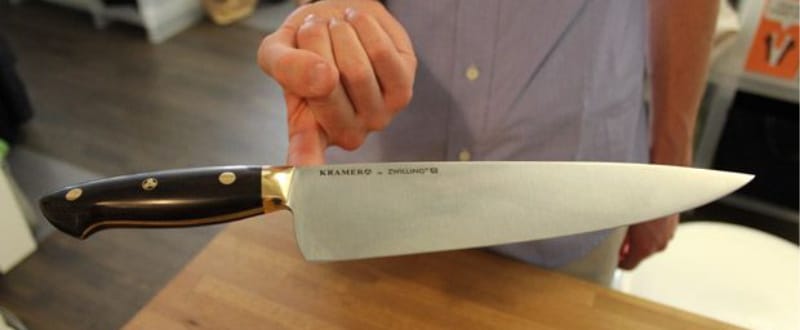
6. How long should the blade be?
- The larger the chef's hand, the larger the blade size he can afford, and vice versa, the smaller the hand - the smaller the tool should be, although this is certainly not the rule, but rather the recommendation for non-professional chefs;
- Small kitchen knives are safer, but larger ones can cut more food at a time;
- Keep in mind that most often the length of the blade of European knives is measured in inches. Chefs are typically 8, 10, and 12 inches long.
7. Japanese or European?
Chef knives are divided into three groups: Japanese, European (Western) and knives made in Japan, but adapted to the "European". In this photo you can see the difference between a hybrid (Misono) and a typical euro-chef from Henckels.
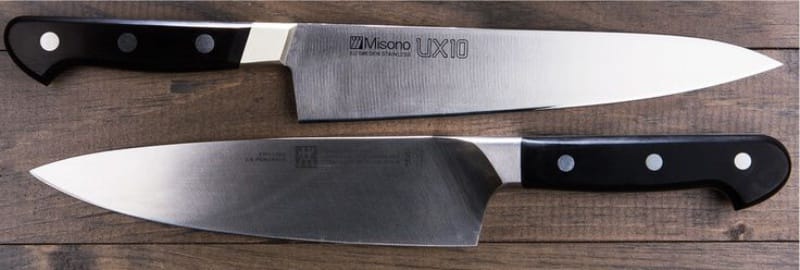
- At home, it is preferable to have a European (Western) type chef, since chopping vegetables or, for example, chopping chicken is much more convenient for them because of the rounded shape of the cutting edge and the blade sharpened on both sides.
- Traditional Japanese knives are more suitable for true connoisseurs of knife art and lovers of Japanese cuisine. In the classic "Japanese" blade sharpening is one-sided, very thick butt, the shape of the cutting edge is almost straight, and it can only be sharpened on water stones. The main way of working with it is vertical movements, that is, practically cutting. In general, this tool can not be called universal.
- But another category of Japanese knives, that is, Western-style knives-hybrids, have gained popularity all over the world and are valued for the very high quality of steel that keeps grinding for a long time. But they have one big minus - it's all the same demanding care. The most famous Japanese knives are Misono (pictured above) and Shun.
If you are interested in the topic of Japanese knives, we suggest you to watch a video review about a European chef and a Japanese hybrid in Western style.
8. Buy good accessories: a board, a block for storing kitchen knives, tools for editing
- Kitchen knives require respect for themselves. They should be stored separately from other devices - in wrapped fabric, in a special unit for storing kitchen knives or on a magnet.
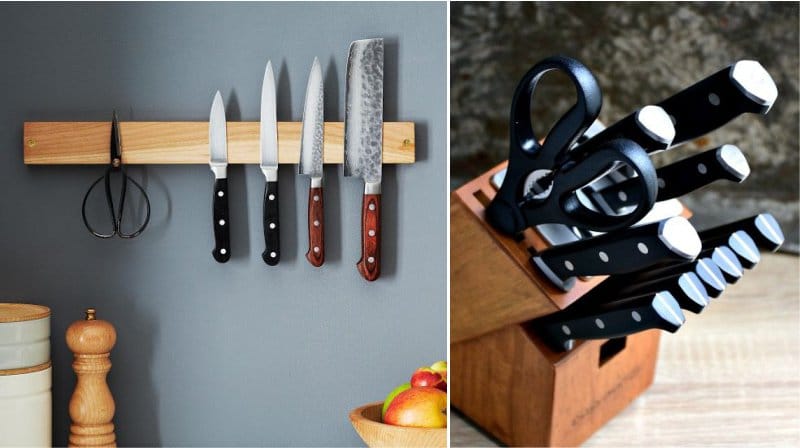
- The board in no case should not be plastic or glass, only wooden or bamboo boards are worthy of the bosses.
- Guide to choosing a good universal pan
- Choosing dishes for glass-ceramic plates (standard and induction)
- The choice of pans for universal use: a comparison of 7 species, 6 tips and 1 video
- How to clean the pan outside and inside - 8 simple ways for difficult cases
- A guide to choosing a dryer for dishes
- How to clean stainless steel spoons and forks - 12 ways

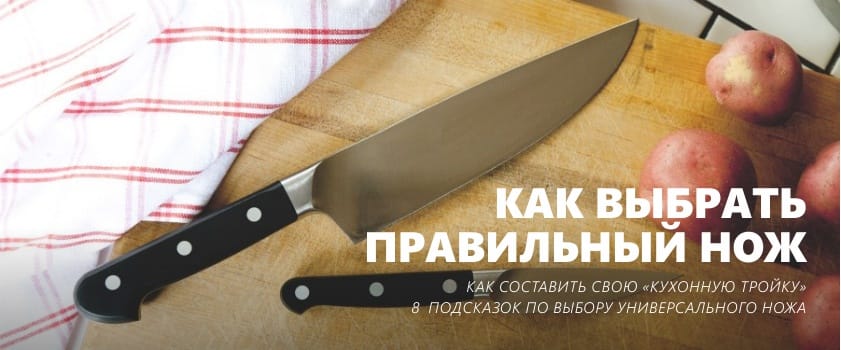
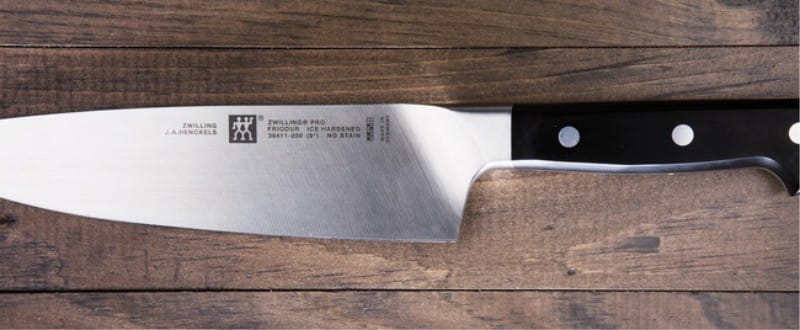
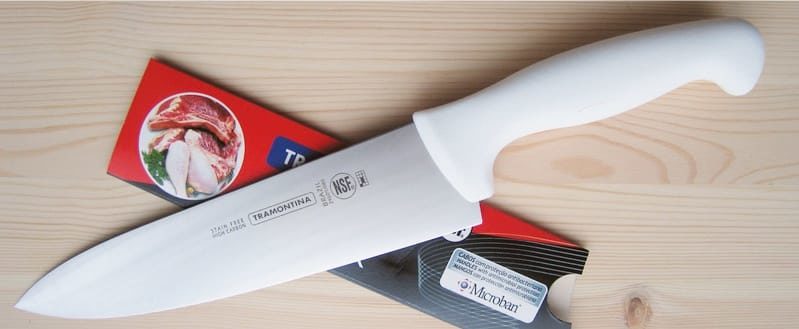
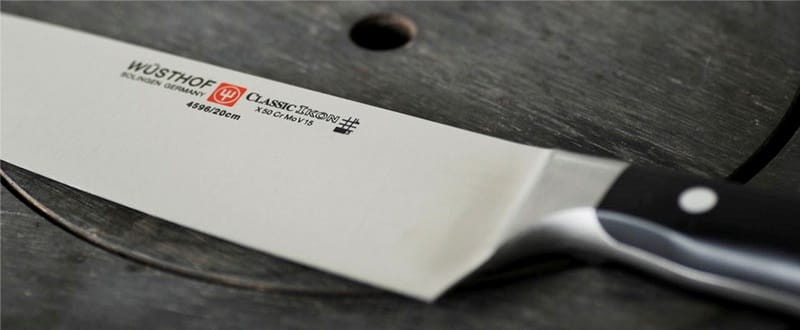
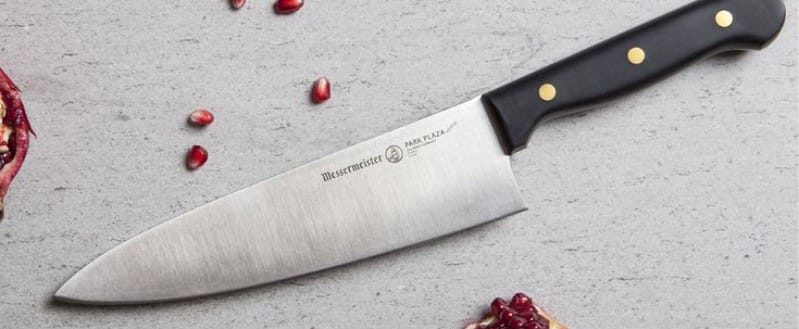
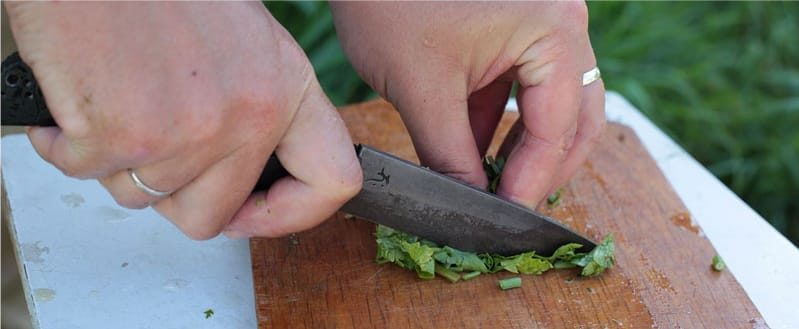
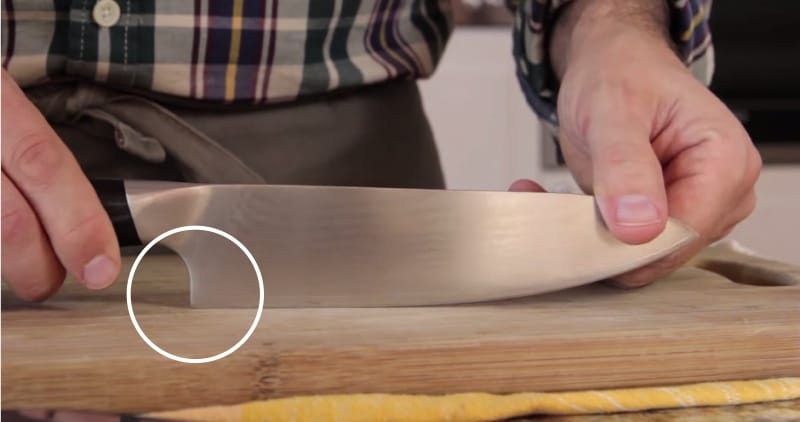


 (Rate the material! Already voted:60 average rating: 4,80 from 5)
(Rate the material! Already voted:60 average rating: 4,80 from 5)
Loved the moment about sharpening kitchen knives. It turns out that until now I’ve just knocked and grinded my knives from GRAFEN MASTER, but they still cut them, and now I’ve sharpened the advice here and I will tell you heaven and earth.
Many thanks for the review. Just pick up the chef's knife. One important point is not touched here. Should there be recesses on the blade? I have a dredging on it and it doesn’t stick to it, but on a Japanese hatchet the blade is smooth, it is very inconvenient to shred them greens or cut zucchini / cucumbers. sliced thin slices of vegetables constantly stick to the blade. When shredding green in general, the whole knife is "green." Wouldn't the same negative effect here? I chose to compare now two chefs, so that has a smooth blade Zwilling J.A. Henckels is more expensive (about 10K), and which is just with the Acros notch - it is cheaper (8K). Thanks in advance if you can help with the answer.
Thank. Very useful video.